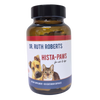A low methionine diet can be a fascinating approach for pets, particularly when dealing with certain health conditions like cancer. Methionine is an essential amino acid, meaning it must be obtained through diet, and it's crucial for various bodily functions, including DNA repair and protein synthesis. However, in the context of cancer, restricting methionine can have some intriguing benefits.
What Is Methionine?
Methionine is an essential amino acid, which means it is one of the basic building blocks of protein that the body needs but cannot produce on its own. Because it is “essential,” methionine has to be obtained entirely from food in the diet.
Key roles:
-
Methionine is needed to make muscles, organs, and important enzymes your pet’s body uses every day.
-
It provides sulfur, which supports a shiny coat, healthy skin, and strong nails or claws.
-
Methionine helps the liver remove toxins and stay healthy.
-
It turns into SAMe, a natural compound that supports brain function and overall wellness.
Because of these roles, methionine is important for growth, tissue repair, immune function, and coat/skin health in people and animals.
Dietary Sources of Methionine
Animal-based sources (richest) |
Plant-based sources |
|
|
Why Use a Low-Methionine Diet if Methionine Is Essential?
Methionine is essential, which only means:
your body (or your pet’s body) cannot make it, so it must come from food.
That doesn’t mean you always have to feed a high amount. So there are two main reasons you’ll see “low methionine”:
Therapeutic / Experimental Diets
-
In some research and medical contexts (cancer, metabolism studies), scientists or vets use controlled, low-methionine diets to see if reducing it (not removing it completely) can slow tumor growth, improve insulin sensitivity, etc.
-
The diet is still designed to meet minimum needs so the body doesn’t become severely deficient, but the level is kept lower than usual to test specific health effects.
-
This is always meant to be carefully balanced and supervised, not something random you try without guidance.
Naturally Low Intake or Deficiency
-
Some diets (for example, very low in animal protein or poorly balanced home-made diets for pets) may be low in methionine without meaning to be.
-
In that case, “low methionine” is a problem, because the body can’t build proteins properly, and you can see issues with muscles, coat/skin, liver, etc.
Benefits of a Low Methionine Diet
Cancer Management: Research has shown that cancer cells often rely heavily on methionine for growth and survival. By restricting methionine, you can potentially starve the cancer cells, making them more susceptible to treatments like chemotherapy. This approach has been observed in studies where tumors in mice shrank when methionine was restricted
Improved Insulin Sensitivity: A low methionine diet may also help improve insulin sensitivity and lipid metabolism, which can be beneficial for pets with metabolic issues. This can lead to better weight management and reduced systemic inflammation.
Implementing a Low Methionine Diet
For both dogs and cats, it’s important to remember the big picture: methionine is an essential amino acid, so even if you aim to lower it, the diet still has to meet minimum requirements set by standards like AAFCO or FEDIAF.
If methionine is restricted too aggressively, it can lead to sulfur amino acid deficiency, which harms the skin and coat, weakens muscles, and impairs immune function. Because of this, any dietary change should focus on making methionine slightly lower but still adequate, never very low or completely removed.
When to Even Consider a Low-methionine Approach
A low-methionine diet should only be used under the guidance of a veterinarian or a veterinary nutritionist. It’s typically considered when a pet has cancer and an oncologist believes a slightly lower methionine level might complement other treatments, or when a pet is part of a research study or has a very specific metabolic condition that calls for it.
It’s not recommended for healthy pets, for general “longevity” purposes, or for animals that are growing, pregnant, nursing, underweight, or already dealing with significant illness—these pets need full, reliable amino acid support.
Special Issues for Cats vs Dogs
Cats
Cats have unique nutritional needs because they are obligate carnivores. They naturally require high animal protein along with taurine and sulfur-containing amino acids. While cystine can cover part of this requirement, methionine is still extremely important. If levels drop too low, cats may show changes like a dull coat, less muscle, or reduced energy. Because cats rely so heavily on balanced amino acids, only very small, carefully planned reductions should be made, always with a veterinary nutritionist designing the diet.
Dogs
Dogs are generally more flexible than cats, but they still have specific minimum needs for methionine and cystine. Plant-heavy or plant-only diets can sometimes fall short, making methionine the first nutrient to become limiting. If methionine drops too far, a dog can develop signs of protein deficiency even when they appear to be getting enough calories. For this reason, any reduction must be controlled and nutritionally balanced, not simply achieved by cutting protein.
How a Vet-supervised Low-methionine Plan is Usually Applied
1. Before Changing Food
Your vet or nutritionist will first review your pet’s current diet (including treats and supplements), check overall body and muscle condition, and assess coat and skin health. They’ll also run baseline bloodwork to understand your pet’s starting point, especially if cancer is involved.
2. Use a Properly Formulated Diet
A safe low-methionine diet still meets AAFCO/FEDIAF minimums for methionine + cystine. To lower methionine safely, the vet will choose carefully selected protein sources rather than simply cutting protein. This usually means using:
-
A prescription/therapeutic diet, or
-
A veterinary-nutritionist–designed home-cooked recipe with specific ingredients and supplements.
Avoid DIY diets: Human “low-methionine food lists” don’t meet pets’ needs for taurine, vitamins, minerals, or full amino-acid balance.
3. Transition Gradually
Introduce the new diet slowly to help your pet adjust comfortably. Mix a small amount of the new food with the old over 7–10 days, increasing the new portion little by little. Keep an eye on how your pet feels, most adjust without issues. If your cat or dog seems less interested in the food or has mild stomach changes, just pause and let your vet know if you need guidance.
4. Ongoing Monitoring
Once your pet is on a low-methionine diet, keep an eye on their weight, muscle tone, coat, skin, energy, and appetite. Changes like weight loss, a dull coat, or lower activity can mean the diet needs adjustment. Your vet will usually recheck your pet every 4–8 weeks, monitoring body condition and running bloodwork to make sure protein and sulfur-amino-acid levels stay healthy. The diet can be updated as needed based on these results.
Key Risks and Things to Be Aware Of
Deficiency and Muscle Loss
Over-restricting methionine / cystine leads to loss of lean body mass, poor coat, and weakened immune function.
Immune and Cancer Interactions Are Complex
Some lab work suggests methionine restriction can slow tumor growth, but other studies show it can also impair T-cell responses and worsen outcomes in animals with intact immune systems. That’s why oncologist guidance is crucial.
Life Stage Matters
Growing, pregnant, and lactating animals have higher amino acid needs and should not be on restricted diets unless part of a tightly controlled trial.
Cats Are High-risk
Because of their strict carnivore biology and extra taurine requirement, cats are much more likely to be harmed by amino-acid restriction than helped if the diet isn’t perfectly formulated.
How the CrockPET Diet Fits with a Low Methionine Approach
-
Customizable Ingredients: The Original CrockPET Diet is inherently flexible, allowing you to adjust the types and amounts of ingredients to meet your pet's specific needs. For a low methionine diet, you can focus on incorporating more plant-based proteins and reducing animal proteins, which are typically higher in methionine
-
Whole Foods Focus: By emphasizing whole, unprocessed foods, the Original CrockPET Diet naturally supports a lower methionine intake. Many fruits, vegetables, and certain nuts are low in methionine, making them suitable choices for this dietary approach
-
Nutritional Balance: Even when modifying the diet to reduce methionine, The Original CrockPET Diet ensures that your pet receives essential nutrients. It's been reviewed by a Board-Certified Veterinary Nutritionist and is balanced for all life stages according to AAFCO standards, so you can be confident in its nutritional adequacy
-
Support for Health Conditions: The diet is designed to be anti-inflammatory, which can be beneficial for pets with cancer or other chronic conditions. By reducing inflammation and providing balanced nutrition, it supports overall health and well-being
-
Guidance and Adaptation: If you're considering a low methionine diet for your pet, working with a holistic vet or pet nutrition expert can help you adapt the CrockPET Diet to meet your pet's unique needs. This ensures that while methionine is restricted, your pet still receives all necessary nutrients for optimal health
Final Thoughts
While a low methionine diet can offer potential benefits, especially for pets with cancer, it's not a one-size-fits-all solution. Each pet's needs are unique, and dietary changes should be made with careful consideration and professional guidance.
The Original CrockPET Diet is a versatile and balanced approach that can be adapted to support various health needs, including those requiring a low methionine diet. This diet is designed to provide species-appropriate nutrition, ensuring that pets receive the right balance of protein, fat, and carbohydrates while also allowing for modifications based on specific health conditions.
If you're interested in exploring how the CrockPET Diet can be tailored for your pet's specific health needs, book consultation with our certified Holistic Pet Health Coach.
















